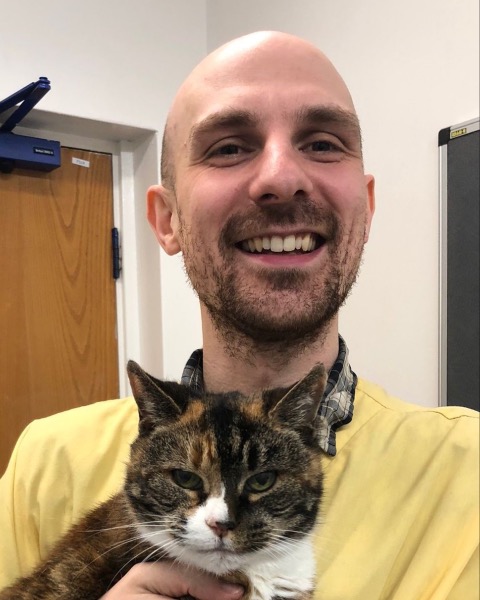Back
Small Animal Internal Medicine
In Person Only
NU08 - Feline Small Intestine Regional Distribution of mRNA Expression of Phosphate Cotransporters and Intestinal Alkaline Phosphatase
Thursday, June 6, 2024
1:45pm – 2:00pm CT
Location: MCC 103 A
CE: 0.25

Jason P. Bestwick, BVMedSci BVM BVS MPhil DACVIM (SAIM) MRCVS (he/him/his)
PhD Candidate
Royal Veterinary College
London, England, United Kingdom
Research Abstract - Oral Presenter(s)
Abstract:
Background – Dietary phosphate restriction is the mainstay of management for cats with chronic kidney disease (CKD), however, molecular mechanisms of feline intestinal phosphate metabolism/transport remain unexplored.
Hypothesis/Objectives – (1) determine mRNA expression of 3 phosphate cotransporters (NaPi2b/SCL34A2, PiT1/SLC20A1 and PiT2/SLC20A2) and intestinal alkaline phosphatase (IAP/ALPI; catalyst of phosphate monoester hydrolysis, thereby aiding intestinal phosphate absorption) in feline small intestine; (2) qualitatively describe IAP distribution.
Animals – Intestinal samples acquired, with informed consent, during post-mortem examination from 16 client-owned cats euthanised for health reasons.
Methods – Quantitative PCR was used to assess relative gene expression (RGE) of SLC34A2, SLC20A1, SLC20A2 and ALPI in RNAlater-fixed intestinal samples (14 cats), using ribosomal protein S7 as a reference gene. Formalin-fixed paraffin-embedded intestinal samples (15 cats) were stained for IAP using a naphthol-azo-dye-based histochemistry.
Results – SLC34A2 RGE increased sequentially from duodenum to ileum, whereas SLC20A1 and SLC20A2 RGE was highest in the jejunum (Figure 1). ALPI expression was not significantly different between intestinal regions (Figure 1). IAP staining was positive at the level of the brush border in all intestinal regions, but results were negatively affected by delays in sample harvesting or prolonged storage in formalin.
Conclusions and clinical importance – The regional variation of active phosphate cotransporters in the small intestine differs from rodents and thus appears unique to the cat. IAP is expressed ubiquitously (mRNA and protein) throughout the feline small intestine. These molecules could represent future therapeutic targets for reducing intestinal phosphate absorption in cats with CKD.
Background – Dietary phosphate restriction is the mainstay of management for cats with chronic kidney disease (CKD), however, molecular mechanisms of feline intestinal phosphate metabolism/transport remain unexplored.
Hypothesis/Objectives – (1) determine mRNA expression of 3 phosphate cotransporters (NaPi2b/SCL34A2, PiT1/SLC20A1 and PiT2/SLC20A2) and intestinal alkaline phosphatase (IAP/ALPI; catalyst of phosphate monoester hydrolysis, thereby aiding intestinal phosphate absorption) in feline small intestine; (2) qualitatively describe IAP distribution.
Animals – Intestinal samples acquired, with informed consent, during post-mortem examination from 16 client-owned cats euthanised for health reasons.
Methods – Quantitative PCR was used to assess relative gene expression (RGE) of SLC34A2, SLC20A1, SLC20A2 and ALPI in RNAlater-fixed intestinal samples (14 cats), using ribosomal protein S7 as a reference gene. Formalin-fixed paraffin-embedded intestinal samples (15 cats) were stained for IAP using a naphthol-azo-dye-based histochemistry.
Results – SLC34A2 RGE increased sequentially from duodenum to ileum, whereas SLC20A1 and SLC20A2 RGE was highest in the jejunum (Figure 1). ALPI expression was not significantly different between intestinal regions (Figure 1). IAP staining was positive at the level of the brush border in all intestinal regions, but results were negatively affected by delays in sample harvesting or prolonged storage in formalin.
Conclusions and clinical importance – The regional variation of active phosphate cotransporters in the small intestine differs from rodents and thus appears unique to the cat. IAP is expressed ubiquitously (mRNA and protein) throughout the feline small intestine. These molecules could represent future therapeutic targets for reducing intestinal phosphate absorption in cats with CKD.

